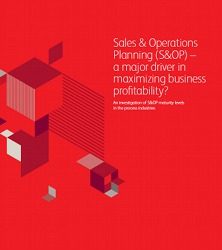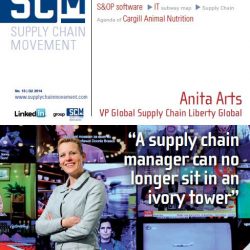The 6 Ultimate Signs of S&OP Maturity

Sales & Operations Planning (S&OP) is a 30 year old horizontal business management process that provides executives with forward visibility on how their business is expected to perform against budget and strategy.
Many companies have implemented S&OP and continuously improved to aim for the highest level of S&OP maturity and create business value. Although there are plenty of S&OP maturity models around to assess how a business is performing, there is unfortunately no agreed world standard.
If you think you’re running a pretty good S&OP process and want to benchmark yourself; what follows are my 6 ultimate signs of S&OP maturity.
1. A Connected Strategy
A company strategy is articulated and connected in the organization to the right levels to guide decision making. Strategic projects and initiatives are periodically visible and milestones are managed.
The ultimate goals of any business is to achieve its vision. The strategy is a long term plan to achieve that vision. The budget is the first your of the strategy. Any decision being made in an S&OP meeting, needs to be in the context to achieve the vision and strategy.
S&OP is there to support strategy deployment, therefore strategic capabilities, strategic intent and strategic projects need to be articulated and cascaded down to S&OP meetings, functional KPI’s and individual performance objectives.
In this way we might prevent as Kaplan & Norton mention; “a fundamental disconnect between the formulation of their strategy and the implementation of their strategy”, resulting in 60%-90% of failure rates of strategy implementation.
2. A Rolling Forecast & Budget
The outcome of every S&OP cycle is a periodic and feasible updated profit & loss (P&L), with gaps versus budget, articulated causals, working capital and cash flow projection.
Periodic visibility of a fully loaded P&L and gaps against budget, provides executives with insights to make the right decisions and change or develop plans to meet the first year of the long term strategy; the budget.
As McKinsey says in Managing the Strategic journey; “To execute strategy…one important capability that companies must develop … is rolling forecasting and budgeting.”
3. E2E Value Chain Risk Visibility
Critical nodes, suppliers, customers, business risks and their P&L impact are identified and included in opportunity and risk scenarios.
Knowing the impact of what your customer or supplier does is one thing. To understand the risks in your whole supply chain network is another. Critical nodes and their impact on the P&L need are known and scenario checked to understand volatility and risks to make the best possible decision. A small unnoticed material from a third tier supplier can be your biggest business risk.
As Jack Berry says in Supply Chain Risks in an uncertain global supply chain environment; “An enterprise may have lowest overall costs in a stable world environment, but may also have the highest level of risk”
4. Resource re-allocation
Workforce or resource requirements for business as usual, budget and strategic projects are periodically re-prioritized and re-allocated if circumstances or assumptions change.
Most business allocate resources once a year; during budget time. S&OP done well provides executives the opportunity to re-allocate resources to their best use under new or changed conditions. Re-allocating resources provides a competitive advantage as McKinsey research shows that “Companies that reallocated more resources earned, on average, 30 percent higher total returns to shareholders.”
5. Periodic Two way Communication
A communication strategy informs, re-focus and engages employees periodically. Structured feedback is gathered on strategy and budget engagement.
Research shows that “information flow is the strongest contributor to good strategy execution”. Every outcome of an S&OP cycle is used as an opportunity to engage with employees, update them on the status of the business, decisions made and re-focus them in new directions if required. This is two way communication so executives also listen to what the business has to say and have a real conversation about budget and strategy progress.
If your company culture is one of fear, S&OP will not change it by itself!
6. Behavioural Competence
Individuals have a positive mindset, are self aware, show effective behaviours and emotional intelligence towards others. People are rewarded for good behaviours.
Effective and sustainable S&OP requires good decision making, pro-actively work across silo’s, constructive conflict resolution amongst many other effective behaviours. In his book ‘Learned Optimism‘ Martin Seligman, a leading psychologist, shows that positivity outperforms negativity. And research from Human Synergistics shows that company cultures with effective behaviours outperform the least effective organizations on inter-unit coordination with 26%.
It is understood by the business that a positive mindset is a must and behaviour is a competence and there is action to include behavioural competence in reward & recognition, recruitment and learning & development policies. As Collins and Porras say in Build to Last; “Imbedded company behaviours will drive a sustainable company culture, which will last over time”. If you want S&OP to last over time, behavioural competence needs to be build.
Surprisingly, some consultancies suggest that a positive mindset and effective behaviours will simply appear as a result of implementing S&OP. This can’t be further from the truth. If your company culture is one of fear, S&OP will not change it by itself! It requires a lot of extra focus, dedication, coaching and hard work.
To tick even one of these 6 boxes, I know a long S&OP journey already has been traveled. If you did tick one or more, congratulations and well done, let me know what your next steps are.
About the author:
Niels van Hove is a Supply Chain consultant and Mental Toughness coach at Truebridges. He is passionate about helping individuals and organizations be themselves at their best. You can contact him at niels@truebridges.com









